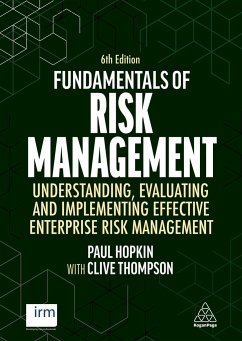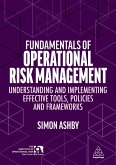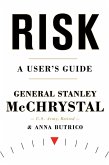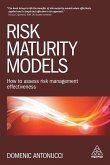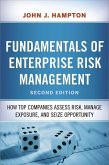Clive Thompson, Paul Hopkin
Fundamentals of Risk Management
Understanding, Evaluating and Implementing Effective Enterprise Risk Management
Clive Thompson, Paul Hopkin
Fundamentals of Risk Management
Understanding, Evaluating and Implementing Effective Enterprise Risk Management
- Gebundenes Buch
- Merkliste
- Auf die Merkliste
- Bewerten Bewerten
- Teilen
- Produkt teilen
- Produkterinnerung
- Produkterinnerung
Develop a complete understanding of the core concepts and frameworks of risk management with this guide designed for emerging professionals and students. This sixth edition is available for students currently studying for the IRM's International Certificate in Enterprise Risk Management June 2025 exam. All students preparing for the December 2025 exam should use the seventh edition.
Andere Kunden interessierten sich auch für
![Fundamentals of Operational Risk Management Fundamentals of Operational Risk Management]() Simon AshbyFundamentals of Operational Risk Management31,99 €
Simon AshbyFundamentals of Operational Risk Management31,99 €![Risk Roulette Risk Roulette]() Graham RuddickRisk Roulette12,99 €
Graham RuddickRisk Roulette12,99 €![Risk Risk]() Stanley McChrystalRisk20,99 €
Stanley McChrystalRisk20,99 €![Risk Culture Risk Culture]() Erik BanksRisk Culture45,99 €
Erik BanksRisk Culture45,99 €![Fundamentals of Risk Management for Accountants and Managers Fundamentals of Risk Management for Accountants and Managers]() Paul M. CollierFundamentals of Risk Management for Accountants and Managers103,99 €
Paul M. CollierFundamentals of Risk Management for Accountants and Managers103,99 €![Risk Maturity Models Risk Maturity Models]() Domenic AntonucciRisk Maturity Models67,99 €
Domenic AntonucciRisk Maturity Models67,99 €![Fundamentals of Enterprise Risk Management Fundamentals of Enterprise Risk Management]() John HamptonFundamentals of Enterprise Risk Management58,99 €
John HamptonFundamentals of Enterprise Risk Management58,99 €-
-
-
Develop a complete understanding of the core concepts and frameworks of risk management with this guide designed for emerging professionals and students. This sixth edition is available for students currently studying for the IRM's International Certificate in Enterprise Risk Management June 2025 exam. All students preparing for the December 2025 exam should use the seventh edition.
Produktdetails
- Produktdetails
- Verlag: Kogan Page
- 6th edition
- Seitenzahl: 472
- Erscheinungstermin: 28. Dezember 2021
- Englisch
- Abmessung: 249mm x 176mm x 39mm
- Gewicht: 1196g
- ISBN-13: 9781398602885
- ISBN-10: 1398602884
- Artikelnr.: 60900222
- Herstellerkennzeichnung
- Libri GmbH
- Europaallee 1
- 36244 Bad Hersfeld
- gpsr@libri.de
- Verlag: Kogan Page
- 6th edition
- Seitenzahl: 472
- Erscheinungstermin: 28. Dezember 2021
- Englisch
- Abmessung: 249mm x 176mm x 39mm
- Gewicht: 1196g
- ISBN-13: 9781398602885
- ISBN-10: 1398602884
- Artikelnr.: 60900222
- Herstellerkennzeichnung
- Libri GmbH
- Europaallee 1
- 36244 Bad Hersfeld
- gpsr@libri.de
Clive Thompson was founding Chair of the Professional Standards and the Interest Group Committees of the Institute of Risk Management where he served on the board and was Deputy Chair until 2020. Based in West Sussex, UK, he has been a risk manager and consultant delivering projects globally. He is a Certified Fellow of the IRM.
Section
ONE: Introduction to Risk Management; Chapter
01: Approaches to Defining Risk; Chapter
02: Impact of Risk on Organizations; Chapter
03: Types of Risks; Chapter
04: Scope of Risk Management; Chapter
05: Principles and Aims of Risk Management; Section
TWO: Approaches to Risk Management; Chapter
06: Risk Management Standards; Chapter
07: Establishing the Context; Chapter
08: Enterprise Risk Management; Chapter
09: Alternative Approaches; Section
THREE: Risk Assessment; Chapter
10: Risk Assessment Considerations; Chapter
11: Risk Classification Systems; Chapter
12: Risk Analysis and Evaluation; Chapter
13: Loss Control; Chapter
14: Defining the Upside of Risk; Section
FOUR: Risk Response; Chapter
15: Tolerate, Treat, Transfer and terminate; Chapter
16: Risk Control Techniques; Chapter
17: Insurance and Risk Transfer; Chapter
18: Business Continuity; Section
FIVE: Risk Strategy; Chapter
19: Core Business Processes; Chapter
20: Reputation and the Business Model; Chapter
21: Risk Management Context; Chapter
22: Risk Management Responsibilities; Chapter
23: Control of Selected Hazard Risks; Section
SIX: Risk Culture; Chapter
24: Risk
Aware Culture; Chapter
25: Importance of Risk Appetite; Chapter
26: Risk Training and Communication; Chapter
27: Risk Practitioner Competencies; Section
SEVEN: Risk Governance; Chapter
28: Corporate Governance Model; Chapter
29: Stakeholder Expectations; Chapter
30: Operational Risk Management; Chapter
31: Project Risk Management; Chapter
32: Supply Chain Management; Section
EIGHT: Risk Assurance; Chapter
33: The Control Environment; Chapter
34: Risk Assurance Techniques; Chapter
35: Internal Audit Activities; Chapter
36: Reporting on Risk Management
ONE: Introduction to Risk Management; Chapter
01: Approaches to Defining Risk; Chapter
02: Impact of Risk on Organizations; Chapter
03: Types of Risks; Chapter
04: Scope of Risk Management; Chapter
05: Principles and Aims of Risk Management; Section
TWO: Approaches to Risk Management; Chapter
06: Risk Management Standards; Chapter
07: Establishing the Context; Chapter
08: Enterprise Risk Management; Chapter
09: Alternative Approaches; Section
THREE: Risk Assessment; Chapter
10: Risk Assessment Considerations; Chapter
11: Risk Classification Systems; Chapter
12: Risk Analysis and Evaluation; Chapter
13: Loss Control; Chapter
14: Defining the Upside of Risk; Section
FOUR: Risk Response; Chapter
15: Tolerate, Treat, Transfer and terminate; Chapter
16: Risk Control Techniques; Chapter
17: Insurance and Risk Transfer; Chapter
18: Business Continuity; Section
FIVE: Risk Strategy; Chapter
19: Core Business Processes; Chapter
20: Reputation and the Business Model; Chapter
21: Risk Management Context; Chapter
22: Risk Management Responsibilities; Chapter
23: Control of Selected Hazard Risks; Section
SIX: Risk Culture; Chapter
24: Risk
Aware Culture; Chapter
25: Importance of Risk Appetite; Chapter
26: Risk Training and Communication; Chapter
27: Risk Practitioner Competencies; Section
SEVEN: Risk Governance; Chapter
28: Corporate Governance Model; Chapter
29: Stakeholder Expectations; Chapter
30: Operational Risk Management; Chapter
31: Project Risk Management; Chapter
32: Supply Chain Management; Section
EIGHT: Risk Assurance; Chapter
33: The Control Environment; Chapter
34: Risk Assurance Techniques; Chapter
35: Internal Audit Activities; Chapter
36: Reporting on Risk Management
Section
ONE: Introduction to Risk Management; Chapter
01: Approaches to Defining Risk; Chapter
02: Impact of Risk on Organizations; Chapter
03: Types of Risks; Chapter
04: Scope of Risk Management; Chapter
05: Principles and Aims of Risk Management; Section
TWO: Approaches to Risk Management; Chapter
06: Risk Management Standards; Chapter
07: Establishing the Context; Chapter
08: Enterprise Risk Management; Chapter
09: Alternative Approaches; Section
THREE: Risk Assessment; Chapter
10: Risk Assessment Considerations; Chapter
11: Risk Classification Systems; Chapter
12: Risk Analysis and Evaluation; Chapter
13: Loss Control; Chapter
14: Defining the Upside of Risk; Section
FOUR: Risk Response; Chapter
15: Tolerate, Treat, Transfer and terminate; Chapter
16: Risk Control Techniques; Chapter
17: Insurance and Risk Transfer; Chapter
18: Business Continuity; Section
FIVE: Risk Strategy; Chapter
19: Core Business Processes; Chapter
20: Reputation and the Business Model; Chapter
21: Risk Management Context; Chapter
22: Risk Management Responsibilities; Chapter
23: Control of Selected Hazard Risks; Section
SIX: Risk Culture; Chapter
24: Risk
Aware Culture; Chapter
25: Importance of Risk Appetite; Chapter
26: Risk Training and Communication; Chapter
27: Risk Practitioner Competencies; Section
SEVEN: Risk Governance; Chapter
28: Corporate Governance Model; Chapter
29: Stakeholder Expectations; Chapter
30: Operational Risk Management; Chapter
31: Project Risk Management; Chapter
32: Supply Chain Management; Section
EIGHT: Risk Assurance; Chapter
33: The Control Environment; Chapter
34: Risk Assurance Techniques; Chapter
35: Internal Audit Activities; Chapter
36: Reporting on Risk Management
ONE: Introduction to Risk Management; Chapter
01: Approaches to Defining Risk; Chapter
02: Impact of Risk on Organizations; Chapter
03: Types of Risks; Chapter
04: Scope of Risk Management; Chapter
05: Principles and Aims of Risk Management; Section
TWO: Approaches to Risk Management; Chapter
06: Risk Management Standards; Chapter
07: Establishing the Context; Chapter
08: Enterprise Risk Management; Chapter
09: Alternative Approaches; Section
THREE: Risk Assessment; Chapter
10: Risk Assessment Considerations; Chapter
11: Risk Classification Systems; Chapter
12: Risk Analysis and Evaluation; Chapter
13: Loss Control; Chapter
14: Defining the Upside of Risk; Section
FOUR: Risk Response; Chapter
15: Tolerate, Treat, Transfer and terminate; Chapter
16: Risk Control Techniques; Chapter
17: Insurance and Risk Transfer; Chapter
18: Business Continuity; Section
FIVE: Risk Strategy; Chapter
19: Core Business Processes; Chapter
20: Reputation and the Business Model; Chapter
21: Risk Management Context; Chapter
22: Risk Management Responsibilities; Chapter
23: Control of Selected Hazard Risks; Section
SIX: Risk Culture; Chapter
24: Risk
Aware Culture; Chapter
25: Importance of Risk Appetite; Chapter
26: Risk Training and Communication; Chapter
27: Risk Practitioner Competencies; Section
SEVEN: Risk Governance; Chapter
28: Corporate Governance Model; Chapter
29: Stakeholder Expectations; Chapter
30: Operational Risk Management; Chapter
31: Project Risk Management; Chapter
32: Supply Chain Management; Section
EIGHT: Risk Assurance; Chapter
33: The Control Environment; Chapter
34: Risk Assurance Techniques; Chapter
35: Internal Audit Activities; Chapter
36: Reporting on Risk Management

